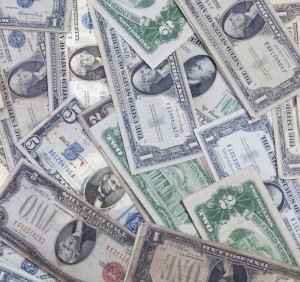
Money is anything that is accepted as payment for goods and services, and repayment of debts. Money functions as a medium of exchange, a store of value, a unit of account, and a method of deferred payment.
Originally, money was a commodity based in physical value. Today contemporary money systems are based on what is called fiat money: money without value as an actual physical commodity. Fiat money is money as we commonly know it because it has been declared so by governments to be legal tender that can be accepted for "all debts, public and private."
Through history money has fueled commerce and, as such, facilitated and created civilization as we know it today. Without a medium to enable commerce, there would be no viable way to establish and maintain the complex network of relationships that comprise community.
The word money is believed to have originated with the Roman temple of Juno Moneta which also served as the ancient city's mint. Therefore, in the collective consciousness it was the entity in the culture from which all relationships were derived, aside from familial relationships and friendships.
Having the mint located in a religious house of worship, in a society where religion and government were intertwined, reinforced the authority of the emerging system of value exchange. Monetta, in turn, is said to have derived from the Latin word monere which means to "remind," "warn," or "instruct." Or possibly from the Greek word moneres, which means "alone," or "unique.
Probably more than anything else in our culture, the concept of money is the most consistent, persistent source of self-identification. For most of us money represents freedom, as it always has, because money provides the resources to facilitate a nearly infinite variety of pursuits. Money can help create autonomy, a sense of wellbeing, power, superiority, flexibility, safety, and many tools.
However, having an abundant supply of money does not necessarily yield self-esteem, dignity or honor.
In ancient Greece, wealth was measured in the form of property and land, most of which was in the hands of the aristocracy. Land and power were inseparable. The aristocrats believed in a closed society wherein the "best" (aristos) people embraced tradition and conservatism, and rejected meritocracy as too radical. Anyone who could transcend his birthright by acquiring more wealth and value, merely by working hard, was considered too great a threat to the aristocracy's power.
As wealth increasingly became measured in terms of money, Aristotle made profound observations that, more than 2,000 years later, still influence our financial markets. For Aristotle, money represented only the commodities it could buy. One could store wealth with money, but money alone was not "wealth" because if one only had money one would ultimately starve.
Money's power is in the value it can obtain. It is a medium of exchange by which people can accrue other components of wealth which in ancient times included property, livestock, implements, and slaves. The more money one had, the more of these components one could buy for oneself, not only to survive but to also flourish. To live not only comfortably, but also morally.
These are aspects of what Aristotle called the "The Good Life," or "Eudemonia." This was a fascinating departure from previous conceptions of money as Aristotle advocated the accumulation of wealth, not as an end in itself, but in the context of attaining a more fulfilling life experience, and living virtuoulsy.
Money was seen as a conduit to pursue pleasure, specifically righteous pleasure that was attuned to morality. Virtue was also a component of the Good Life, defined by Aristotle as the harmony of the soul in compliance with virtue both in moral and in intellectual terms. Money represented the resources to achieve such harmony.
FAST FORWARDING THROUGH ANCIENT HISTORY TO 20TH CENTURY AMERICA
As early as 12000 BC, in ancient China, cowry shells became the first medium of exchange, or money. In 5000 BC metal objects were introduced in Asia as money. The ancient Babylonians established a complex system of lending, borrowing, and holding money on deposit providing letters of credit as early as 2500 BC.
Usury, the lending of money with a charge of added interest, was first practiced by the Sumerians and Greeks as early as 1800 BC. In 700 BC the Lydians became the first civilization in the western world to make coins.
China was the first nation to use make banknotes in the from of leather (118 BC) which then evolved into paper money in China in 960. Paper money developed in Europe in the 500s. Private banks thrived in Venice as early as 1157.
In 1204 following the capture of Constantinople, the goldsmiths of Lombardi became especially influential in financial circles, and established banks in Delft and Calais.
In 1535 strings of beads made from clam shells, called wampum, were used by North American Indians as money.
John Calvin, the Swiss theologian, banned the practice of earning interest on money lending in the 1550s. Interestingly, Calvin felt that loans for business development were sound, but loans to the poor were forbidden.
The first public bank in Europe was founded in Venice in 1584, and was named the Banco di Rialto.
Money was first printed on paste-boards from the standard playing card deck of the day in Canada in 1685.
The Bank of North America was founded in 1781 in Philadelphia.
Alexander Hamilton founded the Bank of New York in 1784.
The first coin minted in the United States was a silver dollar issued on October 15, 1794.
In 1816, England made gold a benchmark of value.
In 1862, the first United States paper money was issued.
On Jekyll Island, in 1910, a group of leading industrialists, bankers, and financiers met to create a "scientific currency" for the United States. This meeting led to the formation of the Federal Reserve in 1913. The core Jekyll Island group consisted of such notables as: J.P. Morgan, Joseph Pulitzer, William K. Vanderbilt, Herbert Lehman, Cyrus McCormick, and Bernard Baruch.
The United States abandoned the gold standard in 1930 in the wake of the Great Depression.
In 1950, Diners Club introduced the first credit card in the United States. American Express introduced their first credit card in 1958.
"Show me the money!" rants Cuba Gooding, Jr. to his agent "Jerry McGuire," a cult money film classic in 1996. Money, money, money. Money is important. Money is the back story of history. Everyone's life is intertwined with money across the board. Money is a universal binder and platform for humanity and culture globally. Investors build buisnesses, create technologies, and enhance societies.
We all need it, we all think about it and we all depend on it. "It is part of every day life." To think otherwise is to be naive, to lack respect for money is foolish, to worship money is limiting; one must put money in perspective.
Bottom-line: money is important and its proper management critical. Money fuels publically traded corporations. Shareholders have a right to monitor corporate spending across every level of company business included, but not limited to: compensation packages, bonuses and commissions, incentive plans, profit sharing, liability costs, political contributions, and any other of the myriad of costs needed to successfully manage a company and stay competitive in today's marketplace.
To contact Christopher Bayer directly, please email Christopher.Bayer@TheShareholderActivist.com.








